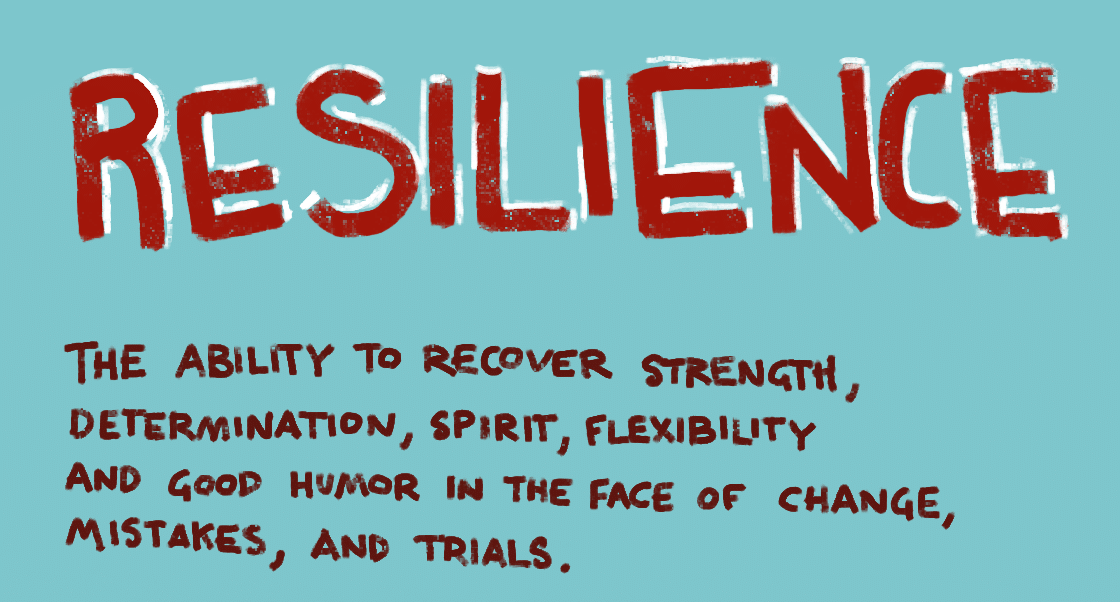This month’s character trait, resilience, takes some nuanced practice to master. Because sometimes, we need a good cry when we fall. Sometimes, we need to embrace failure and our weaknesses. We don’t need to be strong all the time. This is also resilience, on the other side of the coin—finding strength in our own weakness or inability to do it all. But at first thought, being a person who cries when they are hurt feels counterintuitive to being resilient—definitely not the pull yourself up by the bootstraps brand anyway. To this effect, I like the way we define resilience, as the ability to recover strength, determination, spirit, flexibility, and good humor in the face of change, mistakes, and trials. Here the emphasis is recovery—resilience is *eventually* getting back up again, about not wallowing ad infinitum. This way of defining resilience gives space for staying down on the ground for a moment, it doesn’t ask us to endure, or push through stone-faced.

In both individual and collective ways, our resilience has been on trial through the pandemic. For many, it has been blow after blow exhausting as plans and hopes and relationships are strained, sometimes broken. As parents, we look at our children growing up in this landscape, and it can feel overwhelming. But something I’ve learned from children the most through this global pandemic? How to be resilient. How to recover and try again. Like our catch phrase says, The only real failure is to not try again.

Confucious even attributes this to our greatest glory, “Our greatest glory is not in never falling, but in rising every time we fall.” As I coach my child to try again when her block tower crumbles, I remind myself to do the same when I make a mistake at work or when I expect normal to be around the corner and there is more COVID. Our greatest glory is falling, and then *eventually* getting back up again—no stipulation on whether or not tears are shed in the process.

So how do we foster this character trait within ourselves and our children? Below you will find some discussion questions and activities to promote reslience (and respect-full conversations!) within your home:
- Name some instances where you had to try multiple times to succeed. How did you feel when you failed? How did you feel when you finally succeeded (or if you are still working on it, how do you think you will feel when you finally do)?
- Spring Back. Put together a visual example of resilience by finding a spring and flattening it with a heavy book. Show your kids how it bounces back.
- Read stories with characters who are resilient (for a few suggestions, check back to our Resourcefulness Book List for some great book recs!).
- Play Twister. Use this as a physical example of being flexible and having to adapt (like when someone’s hand is on the blue circle you want!).
- Exercise Together. Go for a run or challenge your family to a push-up competition. Physical activity reminds us that our bodies can be super resilient and that strength and flexibility require practice and repetition (just like developing our character muscles!).
- Pull some weeds. This can serve you on multiple levels: (1) it’s an example of persevering through hard work; (2) weeds are super resilient, they grow anywhere with limited water and good soil and seem to always come back; and (3) you get some weeds pulled!
- Try something new! Ride a bike without training wheels, attempt a tricky recipe, explore a new art medium, etc. this month. If/when it doesn’t go right, try again!
- “Good humor” is included in our definition of resilience. What is the value of being able to laugh at our own mistakes or to find the humor in a situation? When there is no humor to be found, do you think “good humor” can mean having a positive attitude or an optimistic outlook?
 Another way to keep this character trait of the month top of mind is to print and hang our Resilience poster! Click here to download.
Another way to keep this character trait of the month top of mind is to print and hang our Resilience poster! Click here to download.
Want more resources? Read Teaching Character Through Literature: Resilience.